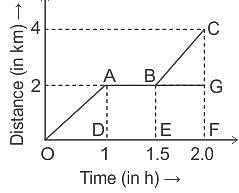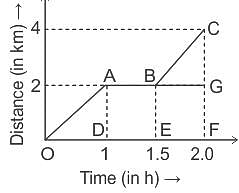Test: Displacement & Velocity - NEET MCQ
20 Questions MCQ Test Physics Class 11 - Test: Displacement & Velocity
The displacement of a particle is given by x = (t – 2)2 where x is in meters and t in seconds. The distance covered by the particle in the first 4 seconds is:
Observe the given distance-time graph.

Identify the respective speeds of the body when it moves from O to A and B to C.

The location of a particle is changed. What can we say about the displacement and distance covered by the particle?
A particle is moving along a circle of radius R such that it completes one revolution in 40 seconds. What will be the displacement after 2 minutes 20 seconds?
The numerical ratio of average velocity to average speed is:
Two escalators move people up and down between floors of a shopping mall at the same rate, either up or down. What of the following statements regarding the motion of the escalators is true?
The displacement of a particle starting from rest (at t = 0) is given by s = 6t2-t3 . The time in seconds at which the particle will attain zero velocity again, is
If a body does not change its direction during the course of its motion, then ______.
A car moves with a speed of 60 km/h for the first half an hour and with a speed of 45 km/h in the next half an hour. What is the total distance covered by the car?
Suppose our school is 1 km away from our house, and we go to school in the morning, and in the afternoon we come back. Then, the total displacement for the entire trip is:
The slope of velocity-time graph for motion with uniform velocity is equal to:
A man starts from his home with a speed of 4 km/h on a straight road up to his office 5 km away and returns to home, then the path length covered is:
Jagadeesh, on driving his way to school, calculates the speed for the trip to be 20 km/hr. After reaching the school he found the school was closed. So he immediately started returning home. While on his return trip, due to less traffic, he calculates the speed to be 40 km/hr. Calculate Jagadeesh's average speed for the entire journey.
A car covers a distance of 5 km in 5 mins, its average speed is equal to:
A car travels first half of the displacement between two places with a velocity of 40 km/hr and the second half at 60 km/hr. Calculate the average velocity for the entire journey.
Which of the following is not an example of a rectilinear motion?
A girl is running around a circular track with a uniform speed of 10 ms-1. What is the average velocity for movement of the girl from A to B ( in ms-1)?


An upward, straight sloping line (left to right) on a distance time graph means:-
|
97 videos|379 docs|103 tests
|

































